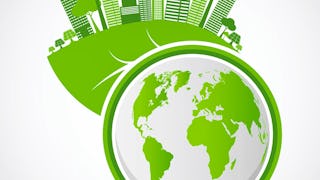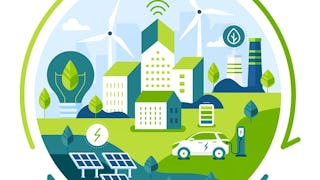As the world’s population continues to rise toward an expected 10 billion citizens by 2050, it is imperative that business practices change to ensure a high quality of life is possible for all of us, both human and non-human. Today’s learners are very aware of this. Moreover, they are highly motivated and have the extraordinary capacity to create a future that provides both economic success and a more enduring, resilient, and sustainable planet. If you are one of these learners, then Sustainability and the Circular Economy is a course for you.
Unlock access to 10,000+ courses with Coursera Plus. Start 7-Day free trial.


Sustainability and the Circular Economy
6,419 人已注册
包含在 中
您将学到什么
Understand the reasons for climate change and its ramifications.
Explain how power is generated today, and its associated impact on global warming.
Recognize how sustainability applies to transportation, homes and cities, food and fashion.
Describe the principles of the Circular Economy, and how the Butterfly Diagram can be used in product design.
您将获得的技能
- Sustainability Standards
- Economics
- Architectural Design
- Sustainable Technologies
- Strategic Leadership
- Sustainable Development
- Organizational Leadership
- Environmental Engineering
- Environmental Policy
- Sustainable Business
- Corporate Sustainability
- Environmental Science
- Sustainable Engineering
- Climate Change Mitigation
- Building Design
- Business Leadership
- Energy and Utilities
- Environment
要了解的详细信息

添加到您的领英档案
23 项作业
了解顶级公司的员工如何掌握热门技能

积累特定领域的专业知识
- 向行业专家学习新概念
- 获得对主题或工具的基础理解
- 通过实践项目培养工作相关技能
- 获得可共享的职业证书

该课程共有6个模块
Welcome to Sustainability and the Circular Economy! This first module introduces the course and how it operates. It then exposes you to the major challenges facing the world today, such as climate change, ocean acidification, biodiversity loss, plastic pollution and social inequity. We capture this with a discussion of planetary boundaries (Rockstrom) and the concept of the Anthropocene. The module ends on a high note with people and organizations that are making real change possible.
涵盖的内容
11个视频5篇阅读材料3个作业2个讨论话题
This module introduces the classic definition of sustainability and sustainable development (Brundtland Commission), along with contemporary concepts of regenerative and restorative practices. We discuss the IPAT equation as a means of providing a macro-view of environmental impacts as a function of population and affluence. The UN Sustainable Development Goals are covered, with a view to how business can impact these in a positive way. The module concludes with an overview of neoliberal economics and the resulting wealth inequality it led to, and a more positive, inclusive model proposed by Kate Raworth in her book, "Doughnut Economics".
涵盖的内容
6个视频1篇阅读材料1个作业1次同伴评审1个讨论话题
This module opens with an overview of the greenhouse effect resulting from greenhouse gases, both good and bad. We then illustrate from the Keeling Curve that GHGs are increasing and have been markedly since the dawn of the industrial revolution. We then discuss the relationship between GHGs and anthropogenic sources, meaning mostly fossil fuels, and the evidence linking the two. We cover the Carbon Dioxide Equivalent, and how one calculates it from GHG emissions and their respective global warming potentials (GWP). The Albedo Effect is then covered as a reinforcing mechanism to climate change. Finally, the module covers the Paris Accord and the need for change.
涵盖的内容
9个视频5个作业
This module is all about conventional power generation using coal, natural gas and nuclear energy. The module begins with how coal, oil and natural gas are formed millions of years ago. We then discuss basic units of heat, power and energy, using both English and International units to communicate in a bilingual way. We dive deeper into nuclear energy, its pros and cons, and whether it should be part of a zero-carbon future. The module wraps up with a discussion of the UN's initiatives called Conference of Parties, or COP, and the resulting outcome of the Paris Climate Accord to limit global warming to 2.0o Celsius.
涵盖的内容
9个视频5个作业1个讨论话题
Now that you understand the global challenges facing all of us, this module showcases the emerging solutions demonstrating the value of sustainable products and to identify them. We cover the areas of transportation, noting the rapid transition to Electric Vehicles, and and developments in E-Planes. As billions of people across the globe migrate to the cities to live and work, there is considerable opportunity to design/redesign cities to be more livable, and this module highlights several successes across the world, including green building and retrofit techniques. We then explore sustainability in daily life, discussing the emerging area of Regenerative Agriculture, the process of growing more nutritious food with zero synthetic inputs, while benefitting the soil. How that food is distributed is changing as well, as consumers everywhere are paying attention not only to what they eat but who is providing it. The module then discusses the clothes that we wear, as consumers are becoming increasingly aware that what they put on their bodies is as important as what they put in their bodies. Apparel and the fashion industry are one of the greatest polluters of all industries, and consumers are demanding change. We wrap-up this module with a discussion of how Fast Fashion is giving way to a new model of Slow Fashion.
涵盖的内容
12个视频3篇阅读材料5个作业1个讨论话题
In this final module, we transition from greenhouse gases, climate change and power generation to the product lifecycle, introducing the concept of the Circular Economy, and how it differs from today's linear economy. We begin with a brief overview of the linear economy, and how it is challenged to support 8 Billion people on the planet. We then show the three basic principles of the Circular Economy, and how it decouples economic growth from resource extraction. We emphasize the work of the Ellen MacArthur Foundation, going through the Circular Economy Butterfly Diagram in detail, with many examples highlighting how this is put into practice. We conclude with an overview of the recycling process, its successes and current challenges.
涵盖的内容
6个视频3篇阅读材料4个作业1次同伴评审1个讨论话题
获得职业证书
将此证书添加到您的 LinkedIn 个人资料、简历或履历中。在社交媒体和绩效考核中分享。
攻读学位
课程 是 University of Colorado Boulder提供的以下学位课程的一部分。如果您被录取并注册,您已完成的课程可计入您的学位学习,您的学习进度也可随之转移。
位教师

从 Environmental Science and Sustainability 浏览更多内容

University of Colorado Boulder

University of Colorado Boulder
人们为什么选择 Coursera 来帮助自己实现职业发展




学生评论
78 条评论
- 5 stars
83.52%
- 4 stars
9.41%
- 3 stars
2.35%
- 2 stars
1.17%
- 1 star
3.52%
显示 3/78 个
已于 Sep 5, 2024审阅
This was a great course to cover basics on sustainability. It could have been better if the section on Circular Economy was more elaborate to include how to make everyday tasks circular ecologically.
已于 Aug 20, 2024审阅
Very interesting course with complete info and good real examples. Highly recommended.
已于 Jun 12, 2025审阅
This is a very complete course for everyone who is interested in learning more about sustainability. Great course !
常见问题
To access the course materials, assignments and to earn a Certificate, you will need to purchase the Certificate experience when you enroll in a course. You can try a Free Trial instead, or apply for Financial Aid. The course may offer 'Full Course, No Certificate' instead. This option lets you see all course materials, submit required assessments, and get a final grade. This also means that you will not be able to purchase a Certificate experience.
When you enroll in the course, you get access to all of the courses in the Specialization, and you earn a certificate when you complete the work. Your electronic Certificate will be added to your Accomplishments page - from there, you can print your Certificate or add it to your LinkedIn profile.
Yes. In select learning programs, you can apply for financial aid or a scholarship if you can’t afford the enrollment fee. If fin aid or scholarship is available for your learning program selection, you’ll find a link to apply on the description page.
更多问题
提供助学金,






